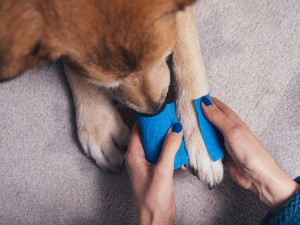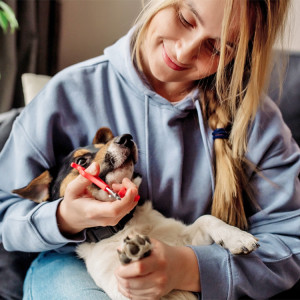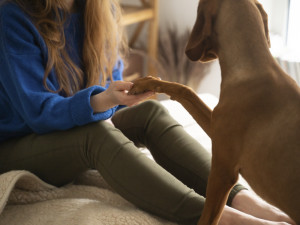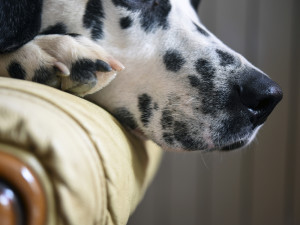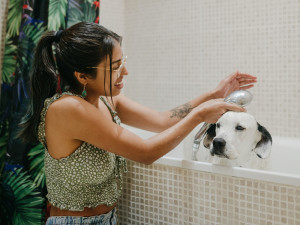Cut Your Dog’s Nail Too Short? How to Stop the Bleeding and Prevent Injury
Even the best pet parent can accidentally draw blood while nail-cutting.

Share Article
In This Article:
What to Do if You Cut Your Dog’s Nails Too Short Tips to Help and Stop Any Bleeding How Long Does It Take for Dog Nails to Heal How to Prevent Cutting Your Dog’s Nails Too Short
Part of caring for your dog includes trimming their nails. If you don’t, they will get too long and may even grow into the pad. This can cause pain and lead to infection. If your dog doesn’t cooperate while you’re trimming their nails, consider taking them to a groomer or veterinarian. Because you can’t just ignore this.
But what happens if you cut one nail too short and expose the quick (a blood vessel inside the nail), causing bleeding and pain to occur? Don’t panic. Read on for everything you need to know about how to keep your dog comfortable while facilitating quicker healing.

What should you do if you cut your dog’s nails too short?
Even if you have trimmed your dog’s nails hundreds of times without a problem, there can come a time when you’ve cut a nail too short. It even happens to vet techs and veterinarians.
Stay calm
You may not realize the importance of this, and there are two reasons why. First of all, dogs pick up on your anxiety, and it makes them stressed, too. Speak in a soothing voice, remain relaxed, and try to keep your dog comfortable. Secondly, if your dog is anxious, their blood pressure will rise, leading to more bleeding. And this can make it difficult to stop the bleeding.
Apply pressure
Assess the situation. Where is the bleeding coming from? Press the area with a clean paper towel or cloth. This may be all you have to do. You should apply firm, steady pressure for two to five minutes before you move the cloth to take a look.
Bandage the wound
If the bleeding continues, wrap the paw with gauze or a pet-safe bandage to control the bleeding. This will protect the broken nail, keep the area clean, and discourage your pup from licking or walking on the nail too much. Just don’t wrap the paw too tightly.
Use styptic powder or pencil
If you clip your dog’s nails, it’s always a good idea to keep styptic powder in your medicine chest. Styptic powder (or pencil) is very effective at stopping nail bleeding. The ingredient in it, ferric subsulfate, constricts blood vessels. Dip the nail in the powder, or apply it with a cotton swab. If you’re using a styptic pencil, wet the tip of it, then gently rub it across the bleeding nail.
Seek veterinary assistance if it’s severe
The nail may continue to bleed regardless of what you do, in which case, you need to consult a veterinarian. If the bleeding hasn’t stopped after 15 to 20 minutes (or if your dog is limping or crying, or the nail is broken or infected), see your veterinarian.
Tips to help and stop any bleeding
You’ll need certain tools and techniques to stop the bleeding quickly and safely. Here are some helpful tips to manage the situation.
Always keep a pet first aid kit on hand, not just for nail issues, but for any problem that may occur. Make sure the kit includes styptic powder, gauze, antiseptic wipes, and bandage wraps.
Use a clean cloth to apply light pressure before applying the styptic powder.
Do not use alcohol or hydrogen peroxide on the nail.
Comfort and distract your dog with treats, gentle petting, or soothing words.
Monitor your dog afterward. Prevent licking and physical activity for a few hours.
How long does it usually take for your dog’s nail to heal?
The healing process for a dog’s injured nail depends on how deeply the quick was cut. If it’s a minor nick, bleeding should stop quickly, and any discomfort will resolve within a day. Mild injuries may result in minor soreness for one to two days, with no additional treatment required.
Moderate injuries typically take three to five days to heal fully. If the quick was deeply cut or the nail has split, it can take up to two weeks to heal. Limping or swelling could be signs of infection and require a vet’s attention.
How to prevent cutting your dog’s nails too short next time
Cutting your dog’s nails doesn’t have to be a terrible experience. If you prepare correctly, you can avoid accidents, and everyone can leave the event happy and unharmed.
Choose the right tools
Using high-quality tools is worth the higher price. Some choices include:
Guillotine-style clippers for small-to-medium dogs
Scissor-style clippers for larger breeds or dogs with thicker nails
Electric nail grinders for gradual trimming, with little risk of cutting the quick
Proper maintenance will also make a significant difference. Replace dull blades regularly.
Proper nail trimming techniques
Look closely at your dog’s nails to become acquainted with the anatomy. The quick appears pinkish and is easily visible if the nails are light in color. If you’re trimming dark nails, it’s a little bit more difficult. For dark nails, trim a little bit at a time and stop when you see a darker oval on the cut surface, which means you’re near the quick.
Grasp your dog’s paw firmly but gently.
Trim at an angle, following the nail’s natural curve.
Clip a small portion at a time, rather than going for a deep cut.
Trim one nail at a time, then take a break if your dog is restless.
Help your dog stay calm
Some dogs hate nail trims. This may be because of previous anxiety or pain, or because it’s the first time they’ve had their nails cut. Here’s how to help them stay calm.
Give treats to associate something positive with a nail trim.
Between nail trims, gently play with your dog’s paws to keep your dog familiar with having their paws handled.
Use pheromone sprays, calming music, or anxiety vests.
If your pup is exceptionally stressed, consider seeking help from a veterinarian or a professional groomer.
You can train your dog to tolerate nail trims. But even better: You can work with them until they enjoy the sessions. It takes time, but it is worth it.
Maintain a regular trimming schedule
It’s essential to establish a regular schedule for nail trimming. Don’t let the nails become overgrown, because this increases the risk of hitting the quick. As nails grow, the quicks also grow, making trimming more difficult.
Keeping your dog's nails short also protects your floors and furniture, while improving your dog’s posture and comfort when they walk.
Bottom line
Accidentally cutting your dog’s nail too short is a common mistake that’s usually easy to fix.
The key is to stay calm, stop the bleeding quickly with styptic powder or gentle pressure, and monitor your dog for signs of discomfort or infection.
Never leave their nails untrimmed. This can lead to ingrown nails, which can cause pain and potentially lead to infection.
If your dog won’t let you cut their nails, seek the assistance of a groomer or vet tech.
References
Edwards, Petra T., et al. “Puppy Pedicures: Exploring the Experiences of Australian Dogs to Nail Trims.” Applied Animal Behaviour Science, vol. 255, Oct. 2022, p. 105730, doi.org/10.1016/j.applanim.2022.105730opens in new tab.
McDonald, Shelby E., et al. “Barriers to and Facilitators of Pet Grooming among Clients Served by a Subsidized Grooming Service Program.” Frontiers in Veterinary Science, vol. 9, 12 Oct. 2022, doi.org/10.3389/fvets.2022.102170opens in new tab 7.
Sydänheimo, Anna, et al. “Cooperative Care Does Not Scare – Use of Cooperative Care Training in Routine Husbandry in Dogs.” Animal Behaviour and Welfare Cases, vol. 2023, 10 Aug. 2023, doi.org/10.1079/abwcases.2023.0010opens in new tab.

Dr. Shelby Neely, DVM
Dr. Shelby Neely is a freelance writer and veterinarian who graduated from the University of Pennsylvania School of Veterinary Medicine and has practiced veterinary medicine for 30 years, specializing in small animals. Her work has appeared in Allivet, AsktheCatDoctor, WhiskerDocs, Ask the Cat Doctor Radio, Ask the Cat Doctor TV, and numerous other websites, brochures, newsletters, newspapers, and ebooks. In her spare time, Dr. Neely likes to spend time with her three children, two grandchildren, three cats, two grand-cats, and five grand-dogs.
Related articles
![A woman trimming a dog's nails]()
How to Trim Your Dog’s Nails
Five simple steps for trimming your dog’s nails at home.
Why Does My Dog Bite Their Nails?
Is that an OK habit for them to have?
![Spotted dog with a close up of his nose]()
What to Do If Your Dog Has a Cracked, Broken, or Torn Nail
A vet explains when you can treat the injury at home—and when it’s best to seek professional help.
![Black Labrador dog sitting on a white fur blanket on a gray couch that has a purple rectangular ScratchPad leaning on the front]()
Miss Independent? Let Your Dog Trim Their Own Nails
ScratchPad is a less stressful solution to claw care for DIY pups.
![Woman carefully cleaning a dog in a bathtub.]()
How to Groom Your Dog at Home: the Complete Guide
Spa days can happen at home.

